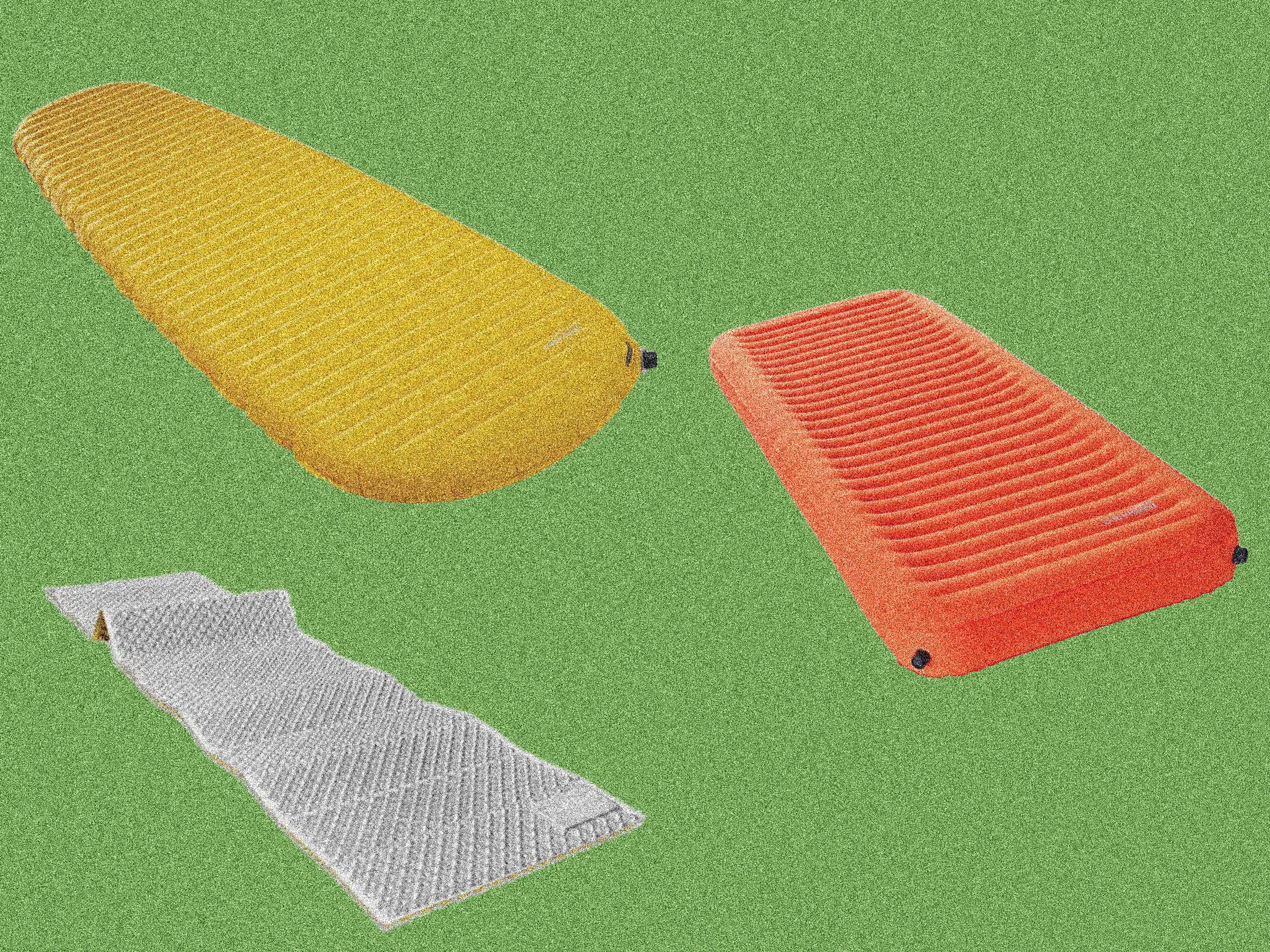All products featured on WIRED are independently selected by our editors. However, we may receive compensation from retailers and/or from purchases of products through these links.
Best All-Around Backpacking Pad
Nemo Equipment Tensor All-Season
Best Ultralight Sleeping Pad
Therm-a-Rest NeoAir Xlite NXT Sleeping Pad
For the Ultimate Backcountry Comfort
Therm-a-Rest NeoLoft Sleeping Pad
Best for Winter Camping
Nemo Equipment Tensor Extreme Conditions Sleeping Pad
What are these sleeping pads you speak of? When I was young, all backpacking was uphill both ways and everyone slept on the ground in sleeping bags with only a half-inch of thin closed-cell foam between us and every pebble. We also filtered our water with our teeth and ate mainly raw meat and foraged ramps. Kids these days.
Still, I suppose there is something to be said for getting a good night’s sleep at the end of a long day on the trail. These days, there’s no shortage of packable, lightweight sleeping pads to make sure no peas (or pebbles) ever disturb your slumber on your next backpacking trip. We’ve spent countless nights on all manner of sleeping pads, and we’re happy to report that in all this time we’ve never had one fail on us. That said, there are some standouts—looking at you, Nemo Tensor All Season—and a few to avoid.
How to Choose a Backpacking Sleeping Pad
Here are some general guidelines to keep in mind when shopping for a new sleeping pad. When backpacking, we suggest sticking with inflatable pads or self-inflating pads (though these are generally heavier), which offer the best insulation and cushioning to size and weight. Whatever you specific needs, your goal is always to find the best warmth-to-weight ratio. More warmth means more weight. Keep the following tips in mind.
Know your intended use. Every ounce counts, and so does the packed size. Smaller, lighter pads take up less room in your pack and are great for a thru-hike where you’re trying to minimize gear size to make room for food. Also, consider the climate. If you plan to camp in Michigan in the fall where cold weather is all but guaranteed, you need a much more insulated pad to protect you from cold ground temps than you do camping in the Everglades in August. Bonus tip: Don’t camp in the Everglades in August.
Know thyself. Everyone sleeps differently, and different pads will be better for different people. Are you a side sleeper who sleeps cold? Go for a thicker pad with more insulation. Sleep every which way and always waking up hot? Get an ultralight pad that’s quiet, so your tossing and turning won’t disturb your tent mates.
Consider your entire sleep system. The pad is the foundation, but how warm you sleep will also be affected by your sleeping bag, pillow, even which base layers you bring. (Many people don’t know this, but sleeping bag temperature ratings assume you’re wearing a base layer.)
You might need two. Sleeping pads are not a one-size-fits-all solution. A lightweight pad that’s perfect on balmy summer nights isn’t going to cut it at an alpine camp in early spring. It might be tempting to just get the summer pad and bring a heavier sleeping bag in spring, but this does not lead to restful nights. A good sleeping pad means the difference between being warm and getting rest or shivering all night, even in the same sleeping bag. Trust us. We do it so you don’t have to.
Comfort is key. I know I joke about sleeping on tiny closed-cell-foam pads, but there’s no need anymore. This guide is proof that comfortable sleeping pads exist and weigh next to nothing. Even though I really did sleep on the ground 35 years ago, you couldn’t pay me to do it now. Now I almost always bring two pads: one inflatable and one thin closed-cell foam. The latter gives me a place to sit in the evening and adds quite a bit of warmth and a no-slip sleeping surface when I need it at night.
They’re a long con by the outdoor industry. Or at least, they were. Now they’ve been standardized so, in theory, you can compare brands’ R-values and it will mean something. If you see the acronym ASTM (or ASTM FF3340), it’s using this new system. If you don’t, it’s pretty much made up. Thankfully, REI has been pressuring brands to adopt the new system, so most of the R-value listings you see today use the standardized system.
So what is an R-value then? A sleeping pad’s R-value is a measure of how much it resists heat flow. (Get it? R for “resists”?) The scale is simple. An R-value of 2 means it resists heat twice as much as a value of 1. So a higher R-value means the pad will better insulate you from the ground. Unlike sleeping bags, where buying too warm of a bag is going to be bad for summer camping, buying a high R-value pad and using it in warm conditions won’t be a big deal. You’re just carrying more weight than you need to.
The problem is that this doesn’t tell you much about how warm you personally will be. Even though an R-value of 4 might be good enough for me to sleep on snow, it might not be good enough for you if you sleep cold. In isolation, R-values tell you very little, even the standardized ones. However, if you have a pad that’s not cutting it and you know it’s an R-2.5, you can look for a pad with R-4 or R-5 and know that it should be warmer.
Sleeping Pad Tips and Tricks
I’ve had very little problems with any inflatable sleeping pad I’ve tested. Some have lost air, but I’ve never had one deflate completely. That said, there are some tricks to getting the best nights sleep and having a pleasant trip.
Don’t inflate your pad with your mouth: For one thing, some of these pads are huge, and it’s just a pain, but also your breath is warm and moist and you’re injecting into nylon, which is a recipe for mildew and mold. Most manufacturers include some kind of pump sack these days, which is fine. There are also motorized pumps that weigh next to nothing, like the Flextail pump.
Don’t over-inflate: Insulated sleeping pads work by putting air and material between you and the cold ground, but that doesn’t mean you need to inflate it until it’s taut. It varies by pad. I generally find that letting out some air yields a more comfortable sleep. The downside is that your pad isn’t as thick and you’re more likely to bottom out. I find this isn’t much of an issue for stomach or back sleepers, but if you’re a side sleeper it might take some time to find the sweet spot between comfort and warmth.
-
Best All-Around Backpacking Pad
Nemo Equipment
Tensor All-Season
Nemo’s Tensor All-Season sleeping pad (8/10, WIRED Recommends) sits at the middle of the Venn diagram of warmth, comfort, and weight. There are lighter pads (see below), but they are not as warm, nor as comfortable. With an R-Value of 5.4 and weighing just 18.2 ounces, the All-Season has the best R-Value-to-weight ratio of anything we’ve tested. That alone is impressive, but what I love about the Tensor is that it’s thick, comfortable, and importantly, pretty quiet. I hate that crinkly sound that’s pretty much synonymous with backcountry sleeping. The Tensor series uses a double layer of reflective film insulation, with a baffled air chamber design, which helps keep it quiet.
The regular wide version has been my go-to choice for trips for the past year, proving itself a capable all-round pad. I even paired it with a Therm-a-Rest Z-Lite for a a few nights on snow and found it performed well. It also packs down well, rolling into a tiny stuff sack. It’s about the size of a 16-ounce Nalgene bottle.
If you want to save a little weight, there’s also the Nemo Tensor Trail for $190. It weighs just 16 ounces for the regular wide, but the R-Value is only 2.8 and overall we prefer the Therm-a-rest XLite below for ultralight trips. Don’t tell the Reddit ultralight police, but these days, most of the time, I ended up taking the Tensor All-Season for the added comfort.
Specs R-Value 5.4 Weight (Regular) 18.2 oz (516 grams) Sizes Regular, Regular Wide, Regular Mummy, Long Wide -
Best Ultralight Sleeping Pad
Therm-a-Rest
NeoAir Xlite NXT Sleeping Pad
The king of the ultralight community, Therm-a-Rest’s XLite series is popular for a reason: It delivers a comfortable night’s sleep while remaining well under 1 pound for the regular size. When your primary concern is weight, this is the pad to get. At 3 inches thick, it’s plenty of protection from the ground, and it’ll be plenty warm in most three-season conditions. You do give up an R-value of 1 compared to our top pick, but you’re saving 6 ounces, which, when you’re trying to go ultralight, is a considerable amount of weight. Part of the weight savings comes from the mummy shape, which while sufficient may leave your arms hanging off the pad if you sleep on your stomach or back (there is the square shaped Max version, but it’s as heavy as the Nemo and not as comfortable).
Therm-a-Rest’s latest version of the XLite uses a new valve system that mean you can inflate it with Therm-a-Rest’s inflation sack. I prefer the Flextail pump, but the sack is marginally lighter. While I try to avoid inflating pads with my mouth, this one has a valve that is particularly large and awkward to inflate that way. I have used both this latest version and an older model that is still going strong, but there is a common complaint that the baffles in Xlite eventually pop. I have at least 100 nights on my older model and have had no issues. The popped baffles seem to come mainly from thru-hikers with 500-plus nights on their pads. My main gripe with this pad is that it’s loud. The newer model is definitely quieter than my older one, but it’s still not as quiet as the Nemo. Still, for the weight, there’s nothing better.
Specs R-Value 4.5 Weight (Regular) 13 oz (370 grams) Sizes Regular Short, Regular, Regular Wide, Large
-
For the Ultimate Backcountry Comfort
Therm-a-Rest
NeoLoft Sleeping Pad
The Therm-a-Rest NeoLoft Sleeping Pad (8/10, WIRED Recommends) isn’t the lightest at 25 ounces, but it packs down respectably small (about an inch thicker and taller than a Nalgene water bottle), and inflates to a massive 4.6-inch cushy pad that looks more like a luxury car camping pad than something for the backcountry. Looks are not deceiving, either. If you prize sleep quality over weight, this is the pad for you. It’s especially great if you’re a side sleeper, where that extra height from the vertical side walls allows for more pressure relief without bottoming out, helping to keep you more comfortable. The R-4.7 rating isn’t that great considering the weight, but it’s more than enough for three-season use. (I would even call it conservative. I tested this pad down to 15 degrees and found it fine, though I am a warm sleeper.)
Part of what makes it so comfortable are the triangular horizontal baffles running through out the pad. There’s two layers of baffles, with the top layer being of a stretchier fabric that helps provide pressure relief, especially for side sleepers. This, combined with the stretch-knit top fabric, which is also excellent for pressure relief, is what makes this pad so comfortable. At the same time, the side baffles help provide support, and I never had this pad “taco” on me. The stretch-knit top helps cut down on that swishy nylon sound (this is a very quiet pad). It also makes sleeping on the pad with a quilt (rather than a sleeping bag) much more comfortable.
The weight makes this pick best for those who prize comfort above all. This is most comfortable sleeping pad I’ve ever used. It’s a wonderfully comfortable pad that will have you forgetting that you’re sleeping on the ground.
Specs R-Value 4.7 Weight (Regular) 25 oz (708 grams) Sizes Regular, Regular Wide, Large -
Best for Winter Camping
Photograph: Nemo Equipment
Nemo Equipment
Tensor Extreme Conditions Sleeping Pad
Nemo’s Tensor Extreme Conditions Sleeping Pad has the highest R-value of any pad we’ve tested. It is the only backpacking sleeping pad that can compete on warmth with car camping pads like Exped’s MegaMat, yet the Tensor somehow manages to pack down to about the size of a Nalgene water bottle and weight just 21 oz. (587 g). Nemo manages this by packing four sheets of metallized thermal film into the trapezoidal chambers. The film is light, packs down small, and both reflects body heat back up to you and stops radiant heat loss to the snow.
I was initially skeptical of this pad. It’s one thing to claim an R-value in lab tests; it’s another thing to spend a sub-zero night on the snow in a Wisconsin winter. But that’s what I did, and this pad performed extremely well. Paired with a Z-Rest (see below) and a -10F sleeping bag, it kept me toasty down to 4 degrees Fahrenheit. The 3.5 inches of loft is nice too, allowing for side sleeping without bottoming out (for reference, I am 5’11”, 165 pounds). My only gripe with this pad (and all Nemo pads) is the regular is insanely narrow. If you don’t want to feel like you’re on a big wall bivouac, go for the wide versions.
Specs R-Value 8.5 Weight (Regular) 21 oz (587 grams) Sizes Regular, Regular Mummy, Regular Wide, Long Wide
-
Best Foam Pad
Therm-a-Rest
Z-Lite Sol Sleeping Pad
I was sort of kidding in the intro, but I also was not. Closed-cell-foam pads like the Therm-a-Rest Z-Lite Sol (mine was some no-name brand) were my intro to backcountry sleeping, and I remain a fan. The Z-Lite and its ilk weigh next to nothing (10 ounces for the small), fold up small enough to lash to the outside of any pack, and double as a chair, extra padding on cold nights, table, you name it. I am too old and too soft to be the sort of ultra-minimalist who gets by with just a Z-Lite, but I still have one around on almost every trip I take. Pairing it with the Nemo inflatable above gives me a wide range of sleeping and sitting possibilities for a total weight of under 2 pounds.
Specs R-Value 2 Weight (Regular) 10 oz (283grams) Sizes Short -
The Extra Backpacking Pad You Must Have
Photograph: Gossamer Gear
Gossamer Gear
Thinlight Foam Pad
Gossamer Gear’s Thinlight Foam Pad is the best thing I’ve added to my backpacking gear kit in the last 10 years. It weighs close to nothing (3.3 ounces for the folded version I have), and I use it constantly. I don’t bring a chair backpacking—never have, never will, as a point of pride. I am a sit-on-what’s-available sort of person. I have no problem lying on the ground pretty much anywhere there isn’t a cactus. Then, last summer, part of the ground crawled up on me, bit me, and gave me Lyme disease. This sucked. Immensely.
Once I was better I started looking for ways to maybe put a slight barrier between me and the ground. A friend loaned me this pad and I took it on a couple of trips and found that I used it constantly to sit on, to pile snacks on during breaks, to lie on for an afternoon siesta, and—the reason it’s in this guide—to go under my inflatable pad to keep it from slipping around at night on the floor of the tent. This last use alone would make it worth its weight.
It wasn’t until the second trip that I figured out perhaps the best bonus use of this pad, and the reason I like the folded version. If you pack the pad against your back, inside your pack, it offers some welcome additional padding for ultralight packs. Gossamer Gear even suggests that you do yoga on it, if that’s your thing. If you buy nothing else on this page, for the love of god, buy this. Trust me.
Specs R-Value 0.5 Weight (Regular) 2.7 oz (76 g) for the rolled, 3.3 oz (94 g) for the folded Sizes Rolled, Folded, Rolled Wide
Honorable Mentions
Photograph: GettyImages
There are dozens of sleeping pads on the market and we’ve tested most of them over the years. While none of these made our top picks, here are some more pads we’ve used and enjoyed.
Sea to Summit Ether Light XT for $150: At just 17.3 ounces for the regular, the Ether Light XT is only marginally heavier than our top pick ultralight pad, and those extra 4 ounces get you quite a bit more cushion. This is a 4-inch thick pad, compared to the 3 inches of the Therm-a-rest X-Lite, which makes it a better ultralight option for side sleepers. I also happen to like the baffle design better and it seems to be a little more durable, making this an excellent alternative ultralight pad. This is also one of the best budget pads around.
Sea to Summit Women’s UltraLight Insulated Air Sleeping Mat for $169: We debated for some time whether women need different air mattresses. After some long conversations with our female testers, we decided there just isn’t much difference. That said, this is a fine sleeping pad for anyone. It’s very close to the Sea to Summit Ultralight above.
Exped Ultra 7R for $220: Our previous top pick for winter use, Exped’s Utra 7R has down insulation side it to achieve the high R-rating. At under 2 pounds for the wide version it’s not that heavy for a four season pad, but it is quite bulky, taking up considerable pack space due to the down. I have used this pad down to 20 degrees Fahrenheit and was very comfortable (in a 10-degree bag). Exped rates it to -20 degrees Fahrenheit. Exped’s widget pump ($55) is excellent, tiny, doubles as a light around camp, and is necessary, as you don’t want the moisture from your breath inside an insulated mat.
Sea to Summit Comfort Plus SI for $125: The self-inflating Comfort Plus inhabits an interesting borderland between car camping pad and backpacking pads. At 3 pounds it’s definitely not light, but if you don’t mind the weight it’s definitely a comfortable option. The open-cell interior offers a nicely cushy sleeping experience. WIRED’s Martin Cizmar says, “I’m a large-bodied side sleeper and my hips didn’t bottom out. In fact, I found it was about 80 percent as comfy as our top pick car camping pad, MondoKing 3D.”
REI Helix Insulated Air Sleeping Pad for $169: This REI pad is comparable to the other ultralight pads in this guide, but it’s noisier and heavier. There’s nothing wrong with this pad; it’s plenty comfy and great for three-season use, but you can get the Sea to Summit Ether Light XT for $20 less and it’s lighter.
Power up with unlimited access to WIRED. Get best-in-class reporting that’s too important to ignore for just $2.50 $1 per month for 1 year. Includes unlimited digital access and exclusive subscriber-only content. Subscribe Today.




